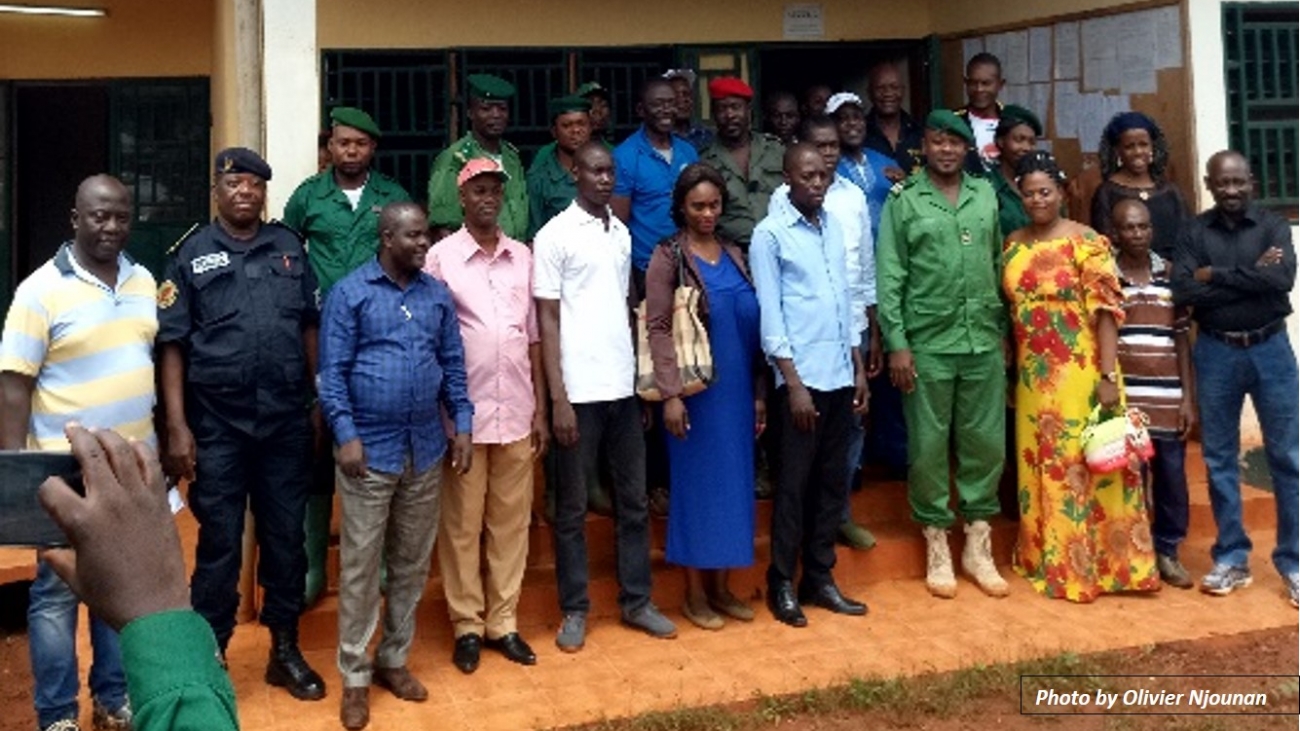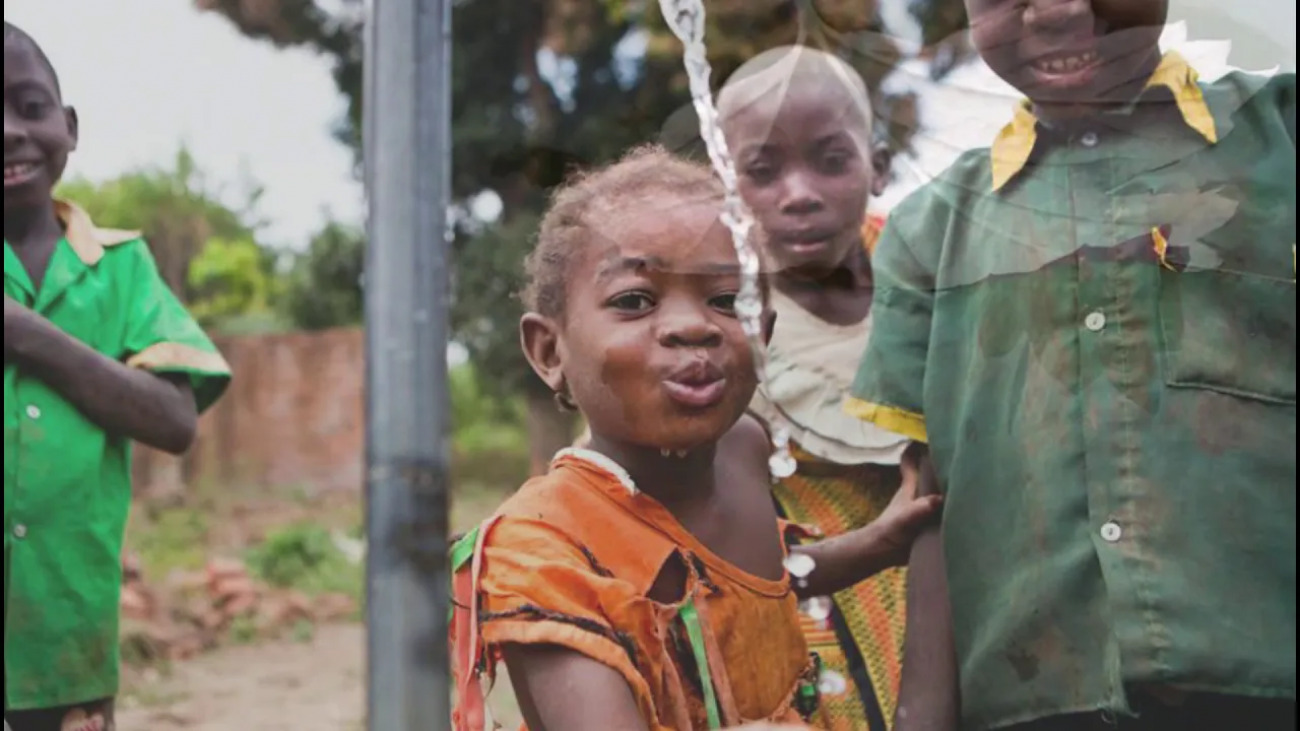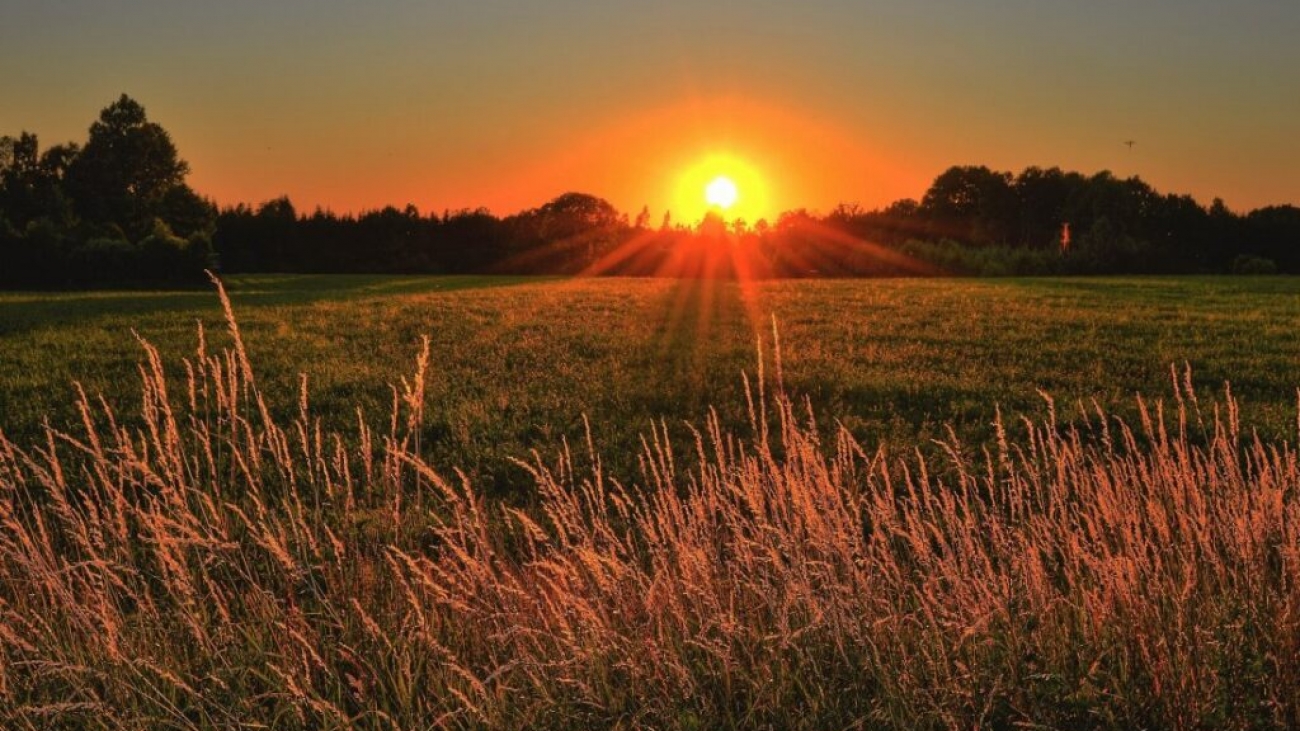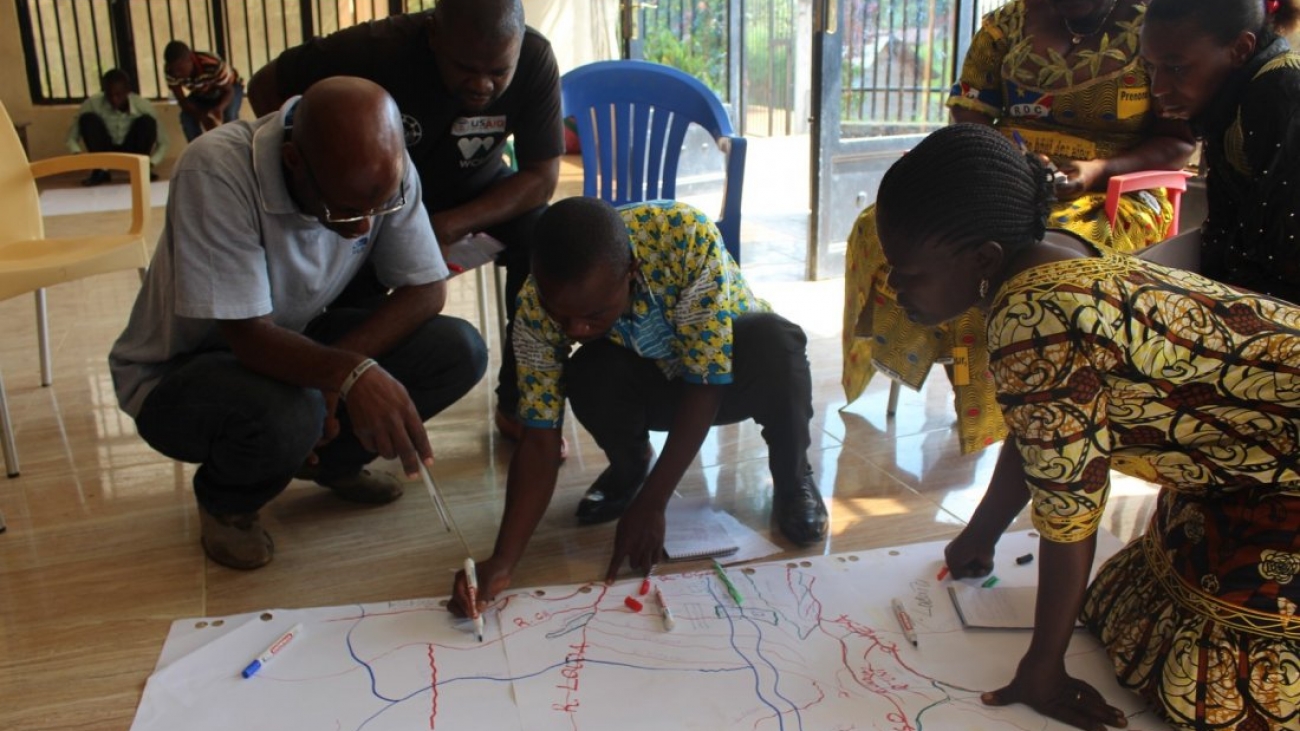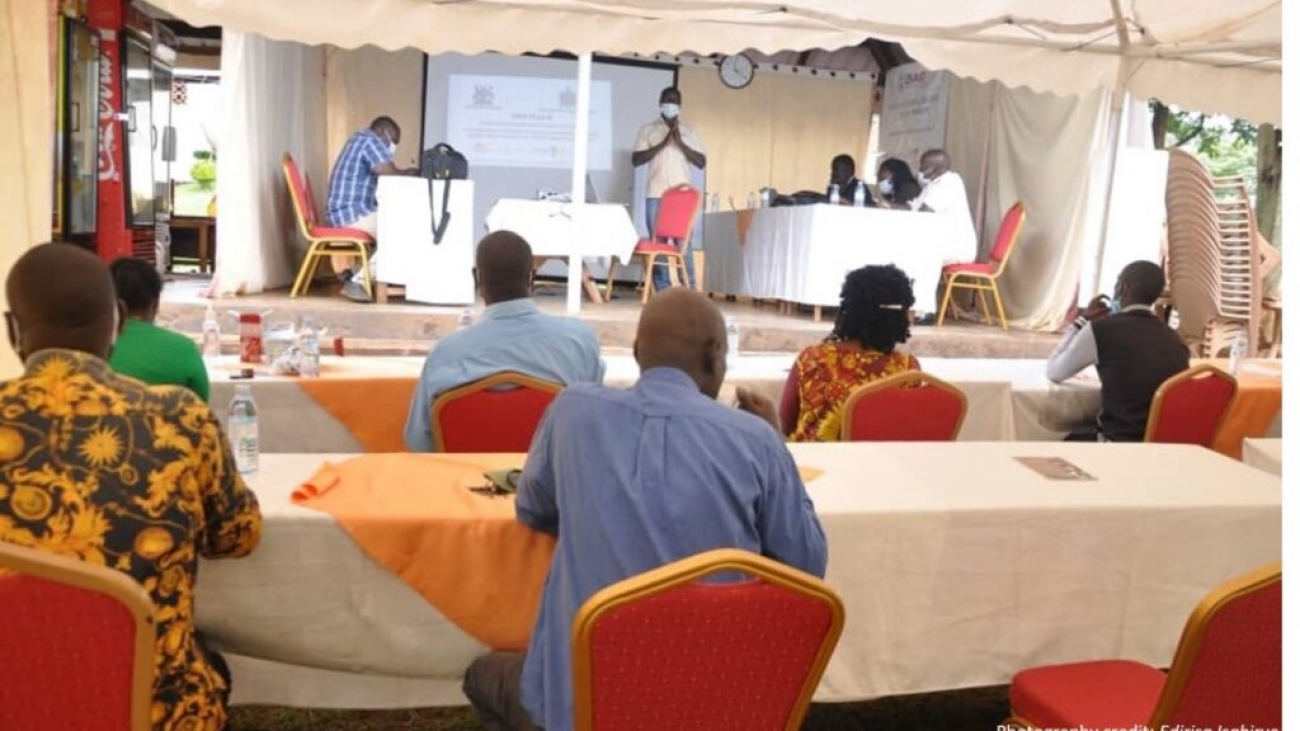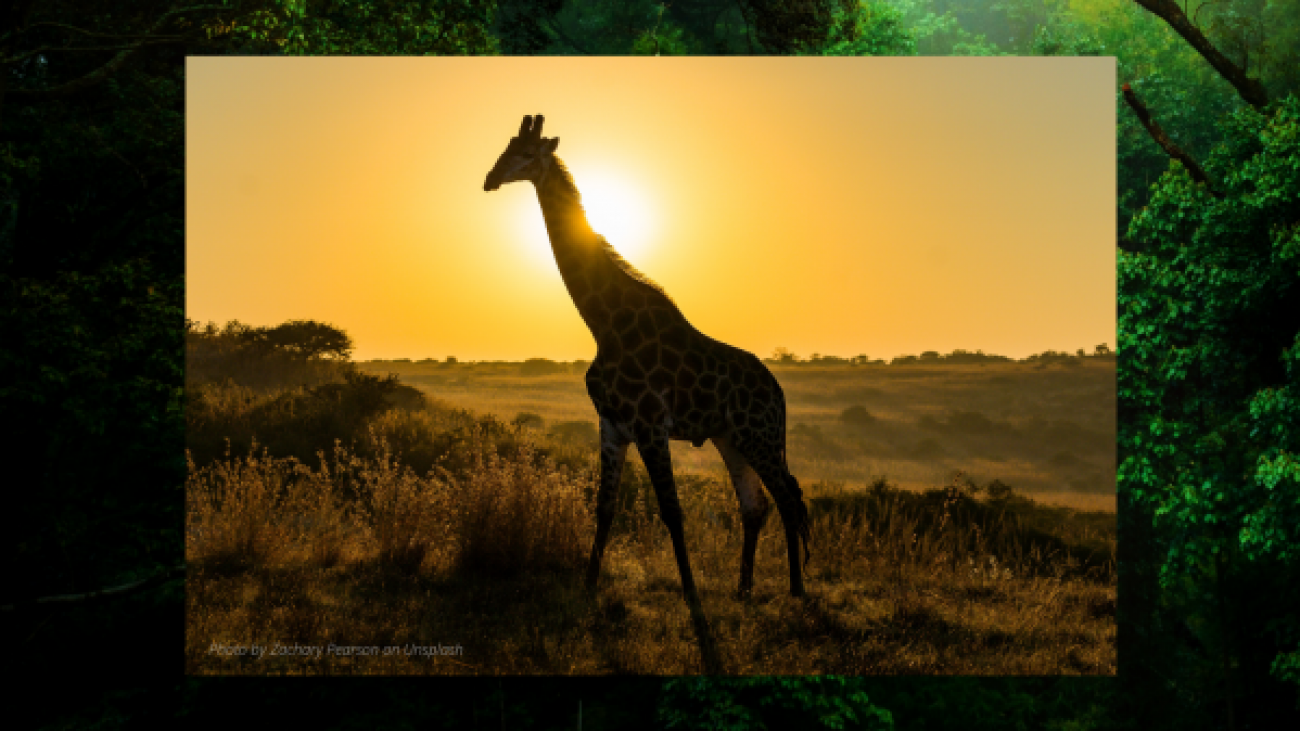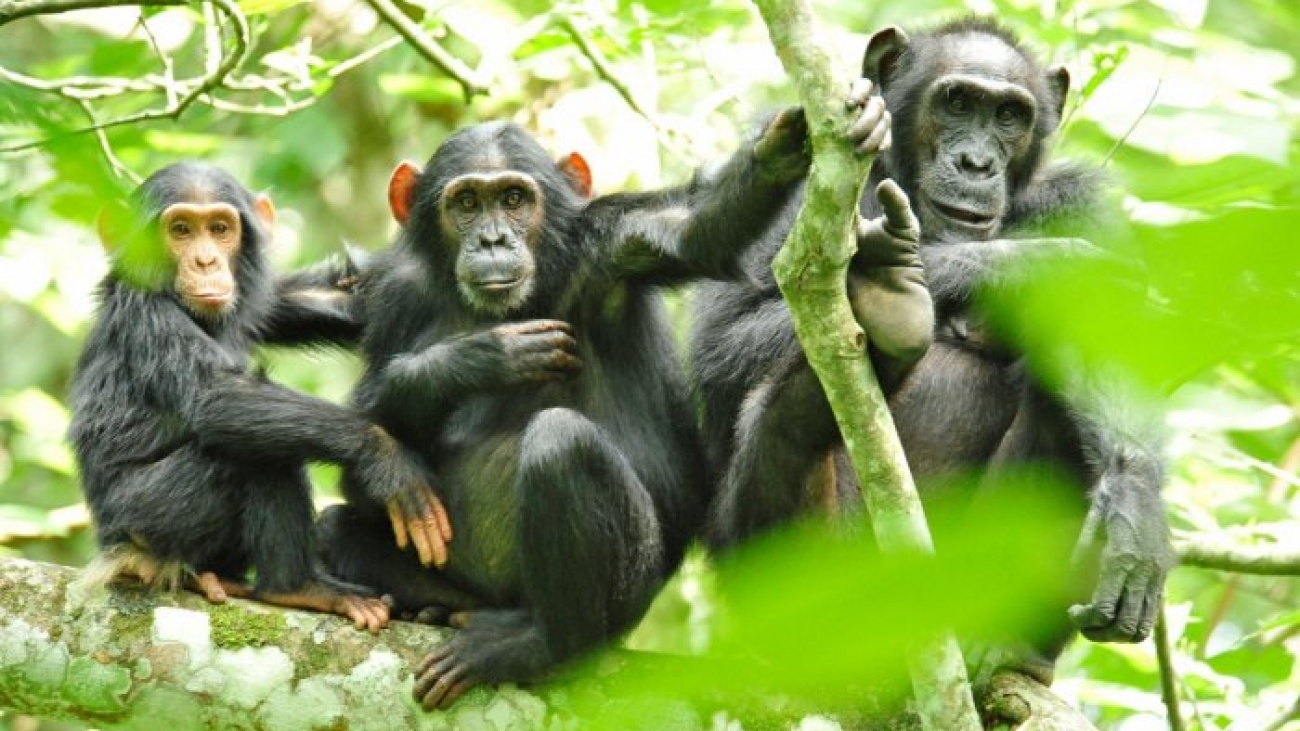One key lesson that ABCG learned at the onset of the Population Health and Environment project was that a difference of perception between actors involved in the activities caused differential levels of engagement. Therefore, one of the most important activity of the project is the mobilization of different stakeholder groups around the project. These mobilization events ensure sufficient and clear understanding of the project’s goals, specific project objectives and expected results.
Water Means Building Resilience among Vulnerable Populations through Integrated Programming: World Water Day 2021
We join the rest of the world in marking World Water Day celebrated on March 22, 2021 by promoting integrated freshwater conservation and WASH (FW-WASH). This year’s theme on valuing water, raises awareness of the vital importance of water to safeguard human security and maintain the health of the planet’s ecosystems. ABCG is reducing watershed degradation and improving the health of freshwater ecosystems through linking freshwater conservation and water, sanitation, and hygiene (WASH).
2020 Achievements, Lessons and Plans for 2021: ABCG Freshwater Conservation and WASH Task Lead Shares
In December 2020, the ABCG FW-WASH task lead, Colleen Sorto, who is also the director of development partnerships at Conservation International, shared a special year-end message reflecting on the year that was coming to an end, and the inspiring work that the task group is looking forward to in 2021. In the message, Colleen shared how the task group made significant progress in pushing forward for the integration of freshwater conservation and Water, Sanitation, and Hygiene (FW-WASH) despite the global challenges. In Uganda for example, a mandate was established at the district level to coordinate and create new tools so that water projects can both include consideration for WASH and environmental conservation. In South Africa, the task group received additional budget and funding for their activities from the district government because of the project intervention connection to WASH investment. Watch the 2 minutes video as well as read the transcript below:
Colleen Sorto year-end message
Hi, I’m Colleen Sorto, I’m the director of development partnerships based at Conservation International’s headquarters in the United States, I’m also the ABCG task lead for the theme on integration of freshwater ecosystem conservation and Water, Sanitation, and Hygiene, also known as WASH. Our task aims to improve the coordination between these two groups of the water sector (freshwater ecosystem conservation and WASH). Our work is focused on field demonstration of successful integrated models, educating community stewards and government champions on these connections, and advocating for policy funding or planning changes to enable integration at a larger scale.
Despite Covid-19, our task members still had some great achievement in 2020. In South Africa, the Conservation South Africa method of clearing alien invasive plants, which both support natural resource management strategies but also increase the availability of water, received additional budget and funding from the district government because of its connection to WASH investment.
In Uganda a mandate was established at the district level to coordinate and create new tools so that water projects can both include consideration for WASH and environmental conservation.
These achievements would not have been possible without our previous efforts with local communities to demonstrate what this looks like in practice.
In 2021, we are going to be releasing a lessons learned report that outlines additional learning from the advocacy process which we hope others in sub-Saharan Africa can benefit from as they also work to improve and promote integrated models of water resource management.
As this year comes to a close and we enter 2021, we sincerely hope to see more conservation and development practitioners adopt integrated approaches to protecting human and ecosystem health. And we hope that our work can continue to inform but also share with practitioners who are looking to grow the FW-WASH community of practice.
ABCG 2020 Highlights

2020 has been a challenging year globally. At the same time, it has provided an opportunity to reflect and envision new possibilities for the future of conservation in Africa and beyond. We have been reminded of the great need to live in harmony with nature and to do our best to ensure that biodiversity is protected and preserved for the greater good of all.
A key focus for ABCG this year has been to take a closer look within, and explore our value and niche in a shifting conservation landscape so as to develop a stronger and more sustainable collaboration. We reflect on some of our accomplishments and challenges in this newsletter, ABCG 2020 Highlights
How ABCG is Implementing Community Forestry in the Democratic Republic of Congo: WRI’s Natural Resources Policy Specialist Explains
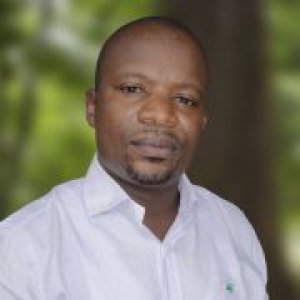 Community-Based Forest Management (CBFM) is the management, by communities or smallholders, of forests and agroforests they own, as well as the management of state-owned forests (some of which share customary tenure and rights under traditional laws and practice) by communities. The Africa Biodiversity Collaborative Group (ABCG) through its CBFM thematic working group is implementing the Community-Based Forest Management project in the Democratic Republic of Congo (DRC). CBFM builds upon ABCG’s previous work on community forests under the Land and Resource Tenure Rights thematic area and is being implemented by ABCG members, World Resources Institute (WRI) and the Jane Goodall Institute (JGI).
Community-Based Forest Management (CBFM) is the management, by communities or smallholders, of forests and agroforests they own, as well as the management of state-owned forests (some of which share customary tenure and rights under traditional laws and practice) by communities. The Africa Biodiversity Collaborative Group (ABCG) through its CBFM thematic working group is implementing the Community-Based Forest Management project in the Democratic Republic of Congo (DRC). CBFM builds upon ABCG’s previous work on community forests under the Land and Resource Tenure Rights thematic area and is being implemented by ABCG members, World Resources Institute (WRI) and the Jane Goodall Institute (JGI).
ABCG talked to Prince Baraka, Natural Resources Policy Specialist at WRI to find out more about the project.
1. What is the importance of CBFM in DRC?
DRC is a country endowed with high forest cover with more than a half of the remaining Congo Basin rainforest found in the region (WRI). According to the World Bank, the Congo Basin rainforest is the second-largest tropical forest on Earth and comprises of about 70% of Africa’s forest cover. These forest’s ecosystem products and services supports the livelihoods of millions of people who live in these areas and beyond making CBFM an important management aspect.
In Community-Based Forest Management, the community takes greater ownership in the management and governance of the forests. With limited state resources for forestry management due to the country’s socio-political and socio-economic situation, implementing this project in DRC offers a cheaper and more effective approach to manage forests. Secondly, state governance of forest resources has proven to be challenging and inadequate in ensuring sustainability of forests. It is also a strategy for reducing poverty and improving conservation by empowering communities to manage their forest resources directly.
“Community forestry is an opportunity to explore conservation out of protected areas, and should be used as a tool to improve local governance and the well-being of forests” Prince Baraka
2. What strategy is the project employing in implementing CBFM in DRC?
We are employing two strategies, the first one looks at promoting and understanding best practices in the implementation of CBFM management plans in DRC for improved conservation outcomes. In this, we are trying to encourage a way of valuing community forestry as a conservation tool and equally as a local development tool. The second strategy focuses on better understanding the impacts of CBFM on forest cover in different landscapes through analysis of satellite imagery and other spatial data across diverse CBFM scenarios.
3. Tell us about some of the approaches you are employing in implementing the strategies.
We have been working on enabling the appropriate policy environment that supports CBFM. To this end, we collaborated with DRC’s Ministry of Environment and Sustainable Development, and other partners, to develop the Ministerial Decree No. 025 which was signed into law in February 2016. It provides rules governing concession management by forest communities. In 2018 and 2019, WRI supported in the development of another Ministerial order which allowed the environment ministry to create a steering committee for the national strategy on community forestry in DRC. Additionally, we have been working on bringing institutional support and involvement in the development of important model tools such as legal frameworks that would support the implementation of CBFM. Further, we have developed an important guide for managing community forests in DRC, titled ‘Guide opérationnel d’élaboration des plans simples de gestion des concessions forestières des communautés locales’.
4. Elaborate further on the guide, ‘Guide opérationnel d’élaboration des plans simples de gestion des concessions forestières des communautés locales’ and its significance to the success of CBFM.
The name of the guide loosely translates to ‘Guide for the elaboration of simple management plans for forest concessions of local communities’ in English. The guide is a reference tool to assist Local Community Forest Concession (CFCL) user groups to set clear goals for management that will improve quality of life of communities whose forests constitute reserves of biodiversity and forest-dependent livelihoods. This offers an opportunity for them to engage in the project activities thereby being the core actors in managing their resources. The guide was developed by WRI (with co-financing from USAID CARPE SCAEMPS program) in collaboration with the Division of Community Forestry and was validated by stakeholders in Kinshasa, DRC in May 2019. In collaboration with the Ministry of Environment and Sustainable Development, translation of the guide into local languages is ongoing. It will serve as the basis for WRI-led distribution to local actors and awareness raising on its application.
5. What are the positive outcomes witnessed as a result of using the guide and model tools developed?
One successful outcome has been the acceptance and validation of the guide by the highest political level, the Minister of Ministry of Environment and Sustainable Development, and communities in Maniema and Kwilu Provinces. The adoption of these model tools has further led to an increase in the number of community forests attained, efficiency in administration service delivery in the provinces, and governance processes are now improved and harmonized.
6. What is the value-add to community members being involved in the project and in which provinces is CBFM being implemented?
By being involved in CBFM activities, community members make actors aware of their needs and concerns. This helps in the design and delivery of interventions that are beneficial to community members such as establishment of Local Community Forest Concession governance structures. Secondly, it enables communities to realize the importance of biodiversity conservation through their active involvement in the whole process of implementing the simple management plan. Lastly, involving communities promotes responsibility, better management of community forests, resource efficiency and reduces management costs for the government and partners as the activities are done by community members themselves. The CBFM project is being carried out in several provinces namely Maniema, Maindombe, Kwilu, Tshopo, Tshuapa, Mongala, North-Kivu and Equateur.
7. Who are some of your local partners in implementing CBFM in DRC?
The partnerships we form are critical for the success of our work, in implementing CBFM, we have partnered with Groupe d’Action pour Sauver l’Homme et son Environnement (GASHE) in Equateur, Réseau pour la Conservation et la Réhabilitation des Ecosystèmes Forestiers (Réseau CREF) in North Kivu, Centre d’Appui à la Gestion Durable des Forêts Tropicales (CAGDFT) and Conseil pour la défense environnementale par la légalité et la traçabilité (CODELT).
8. What are the challenges faced in implementing this project?
Encountering resistance from local communities who refuse to let go of their land can pose a big challenge to this work. Resistance can also come from movements of environmental civil society organizations who regards this process as a dispossession of communities from their land. Therefore, it is difficult to create community forests under the status of a national park, as this option is negatively perceived by the communities. This explains why we are moving more and more towards the creation of reserves and community conservation areas, because it is essential to have the support of local communities who customarily own their forests. Currently, with a view to guaranteeing the preservation of biodiversity, the forest concessions of local communities are considered to be an opportunity to extend conservation areas outside protected areas.
9. Which technique is WRI using to reach and engage with communities during this period of the
COVID-19 pandemic?
WRI staff now have less interaction with the communities and other partners due to the set COVID-19 guidelines. Communication challenges as a result of limited internet access further makes it difficult to engage with the communities as well as implement the planned activities on the ground. To continue our operations during this period, we are working more closely with local NGOs who are able to reach the communities and incorporate the use of the tools we helped to develop.
10. What would you recommend other actors to put emphasis on to ensure the success of CBFM?
It is important for all actors to ensure that community forestry effectively contributes to biodiversity conservation and local development particularly by promoting the local economic fabric through enhancement of natural resources. Promoting the economic benefits to communities is important in increasing the economic value of community forests that contributes to better management of the natural resources.
To learn more about essentials of making community forestry work in the Democratic Republic of Congo, read, In the Democratic Republic of Congo, 3 Essentials for Making Community Forestry Work, by WRI.
Translating On-The-Ground Successes into Policy Action: Advocating For Integrated Freshwater Conservation and WASH in Uganda
The Africa Biodiversity Collaborative Group (ABCG) aims to reduce watershed degradation and pollution by linking Freshwater conservation and Water, Sanitation, and Hygiene (FW-WASH), thereby improving the health of freshwater ecosystems. ABCG’s FW-WASH task group is applying FW-WASH integration tools that have been developed over the course of the project to engage local community actors in development activities.
November 2020 Quarterly News Digest
 The November 2020 Quarterly News Digest features the latest news of The Africa Biodiversity Collaborative Group (ABCG). This issue highlights how organizations can and should embrace integration to help people and nature build back better from the effects of Covid-19.
The November 2020 Quarterly News Digest features the latest news of The Africa Biodiversity Collaborative Group (ABCG). This issue highlights how organizations can and should embrace integration to help people and nature build back better from the effects of Covid-19.
It also shares some of the milestones ABCG has achieved during this quarter such as the launch of the Freshwater Conservation and WASH Advocacy Strategy Workshop Facilitator’s Guide. The guide can be used by conservation, WASH, and development practitioners to develop an effective advocacy strategy that can enable them to deliver positive conservation outcomes.
Read the News Digest to know more about ABCG’s impact and access resources, including the recordings of our past webinars.
What is the State of Our World in 2020? WWF’s Living Planet Report Reveals an Insecure Future
 The new WWF 2020 Living Planet Report reveals that there has been a two-thirds decline in wildlife populations on average since 1970 and calls for urgent action to end the destruction of natural habitats for the health and well-being of humanity and nature.
The new WWF 2020 Living Planet Report reveals that there has been a two-thirds decline in wildlife populations on average since 1970 and calls for urgent action to end the destruction of natural habitats for the health and well-being of humanity and nature.
From the executive summary
‘The global Living Planet Index (LPI) continues to decline. It shows an average 68% decrease in population sizes of mammals, birds, amphibians, reptiles and fish between 1970 and 2016. A 94% decline in the LPI for the tropical subregions of the Americas is the largest fall observed in any part of the world.
Why does this matter?
‘It matters because biodiversity is fundamental to human life on Earth, and the evidence is unequivocal – it is being destroyed by us at a rate unprecedented in history. Since the industrial revolution, human activities have increasingly destroyed and degraded forests, grasslands, wetlands and other important ecosystems, threatening human well-being. Seventy-five per cent of the Earth’s ice-free land surface has already been significantly altered, most of the oceans are polluted, and more than 85% of the area of wetlands has been lost.
Our World in 2020
‘In the last 50 years our world has been transformed by an explosion in global trade, consumption and human population growth, as well as an enormous move towards urbanisation. These underlying trends are driving the unrelenting destruction of nature, with humanity now overusing our natural capital at an unprecedented rate. Only a handful of countries retain most of the last remaining wilderness areas. As a result of our 21st century lifestyles our natural world is transforming more rapidly than ever before, and climate change is further accelerating the change.

‘Social and economic globalisation are undoubtedly the most important forces shaping contemporary societies. Since 1970, total gross domestic product (GDP) has increased four times, the extraction of living materials from nature has tripled and, in total, the global human population has doubled along with an enormous trend towards urbanisation.
‘People living in cities now account for 50% of the global population. In the last 50 years this number has increased more rapidly, by 30%, in developing and least developed countries where many live in slums lacking resources and access to public services. Yet, in the same time period, child mortality decreased overall, more sharply in least developed countries (350% decrease); and caloric intake increased globally by 20%, even though many people in least developed countries are still below the thresholds recommended by the World Health Organization.
‘Migration has also changed the face of our planet. More than 260 million migrants have entered other countries since 1970, mainly developed countries, and this migration occurs increasingly in precarious conditions. The global movement of people across regions increased at an unprecedented pace during this period, producing profound economic gaps.
‘Indeed, trade has exploded with the value of exports rising 200- fold from 1970 to 2017, with the largest increases in developed countries (1,200-fold). This boom has enabled higher-income countries to increase their consumption even though nature, within their own boundaries, is relatively well protected; much of the added consumption is of nature’s contributions imported from lower-income countries, which are sometimes surrendered for little economic growth. Supply chains that depend heavily on nature are often dominated by large corporations and when their, and others’, amassed capital is funnelled through tax havens it can be difficult to regulate the financing of activities that damage the planet’s natural systems.
‘Further, a number of economic policies currently provide incentives to degrade nature − such as direct and indirect subsidies to use fossil fuels, as well as those related to fisheries and agriculture. While eliminating this form of incentive is not impossible, the political complexities and constraints are vast. However, increasingly, some policies offer incentives to reflect the value of nature’s contributions within individual behaviours, as do some private incentives, for example through certified supply chains. Nations also create protected areas, including different types in recognition that empowering local interests in conservation is critical.
‘These patterns of production, consumption, finance and governance, alongside population, migration and urbanisation demographics, are indirect drivers of biodiversity loss as they underlie land-use change and habitat loss, the overexploitation of natural resources, pollution, the spread of invasive species and climate change – the direct drivers of the destruction of terrestrial, freshwater and marine ecosystems.
‘Indeed, one-third of the terrestrial land surface is now used for cropping or animal husbandry, while of the total amount of water that people withdraw from available freshwater resources, 75% is used for crops or livestock.

Climate change is accelerating, leading to the increased frequency and intensity of extreme weather events and sea level rise, putting further pressure on ecosystems and biodiversity.
‘Until now, decades of words and warnings have not changed modern human society’s business-as-usual trajectory. Yet in times of rapid upheaval and disruption new ideas, creativity, processes and opportunities for transformation can arise. The future is always uncertain but perhaps the COVID-19 pandemic will spur us on to embrace this unexpected opportunity and revolutionise how we take care of our home.
Read the whole report, WWF (2020) Living Planet Report 2020 – Bending the curve of biodiversity loss.
Enhancing Integration to Build Back Better: Covid-19 and Adaptive Leadership

Coronavirus, a zoonotic disease, has demonstrated the strong interconnection between ecosystem health and human health. It has demonstrated that no sector can be able to conduct business in a degraded environment, and the need for integration and collaboration among sectors for the health of both people and nature.
Despite these challenges, there are opportunities to shape and define our work to ensure a more resilient ecosystem.
The second series of the Covid-19 and Adaptive leadership webinar, held on October 13, 2020, discussed key practices and integrated solutions for building back better in the midst of a pandemic. Organized by the Africa Biodiversity Collaborative Group (ABCG) and other conservation NGOs, the webinar featured an illustrious set of panelists from both the conservation and development sectors. They included, Alice Ruhweza, Africa Region Director, World Wildlife Fund International; Josphat Ngonyo, Executive Director, Africa Network for Animal Welfare; Lisa Parrot, Regional Programme and Quality Director, Save the Children; and was moderated Lucy Waruingi, Executive Director, African Conservation Centre.
While speaking on the topic of building back better through a green and just recovery, Alice talked about the immense opportunities that the pandemic provides for Africa to build back better through nature. Nature is a critical launch pad in this recovery. Alice highlighted the numerous ways through which nature can aid in the process of building back better through its contributions to the food system, the health system, and the important contribution of nature on the economy.
This pandemic has greatly undermined the resilience of communities. Josphat discussed the practical applications to support people and rural communities to build back better. Among the ways to support communities is through being inclusive in community participation, public support, community empowering and promoting sustainability. Core to this is building and nurturing partnership with communities and integrating them into conservation and development activities.
“There is a clear impact on the livelihoods, health and education system because of the pandemic,” Lisa said. Furthermore, the stress on the livelihoods of communities, has a direct threat to the environment through poaching, deforestation and other negative environmental practices as communities try to secure livelihoods. Lisa mentioned that it would be advantageous to adapt the One Health approach whereby health in the community encompasses the health of people, livestock, wildlife and the environment. This approach ensures that all sectors are provided for as they are interdependent.
The webinar called on the need to enhance integration and partnerships among the conservation, humanitarian, development and other sectors to holistically and effectively address the economic, social and environment concerns of our world.
Click below to watch the webinar recording
Related resources
WWF policy brief: Africa in the context of COVID-19
Save the Children’s report: Protect a Generation: The impact of COVID-19 on children’s lives
Caring classrooms: Lessons plans in humane education
A summary of the Covid and Adaptive Leadership webinar series I: Practices Conservation Leaders Can Employ to Cushion their Organizations During Crises
Linking Integrated Water Resource Management and Water, Sanitation and Hygiene
Most of sub-Saharan Africa is under pressure from increasing population growth, urbanization, and consumption, as well as poorly planned infrastructure development. All these factors are negatively impacting the quality and availability of freshwater resources. Major watersheds attract development, and the resulting development leads to increased pollution due to inadequate wastewater management infrastructure, as well as contributing to increasing and competing demands, which can lead to scarcity (ABCG 2019).

In an effort to bridge this gap, the Africa Biodiversity Collaborative Group (ABCG) Freshwater Conservation and Water, Sanitation and Hygiene (FW-WASH) task group organized a webinar focusing on Integrated Water Resource Management (IWRM) and Water, Sanitation and Hygiene (WASH) linkages in mainly rural settings and how Civil Society Organizations (CSOs) can advocate for their integration in policy and planning.
While speaking at the webinar, Ele Jan Saaf, a Senior Project Manager and Water Management Expert, noted that IWRM and WASH are divergent and emphasized the need to link rather than integrate them. He added that, the concepts of IWRM and WASH are different in that IWRM is a management concept. IWRM is responsible for providing water at the right place, right time, and of the right amount for WASH services or ecosystem services. On the other hand, WASH is a service delivery concept. It takes the water allocated to it by IWRM and ensures it is available as safe drinking water and also ensures the disposal of wastewater is done in a hygienic fashion.
Ele Jan advised WASH practitioners based on techniques the Watershed Program uses for lobbying and advocacy. “In Watershed we have a strong focus on lobbying and advocacy. We also have a strong focus on messaging and working with the CSO partners in our countries to make sure they are able to develop messaging and identify the target group for their lobbying and advocacy activities within the spheres of IWRM and WASH,” said Ele Jan.
When it comes to messaging in lobbying and advocacy, WASH practitioners should focus on clarifying where the links between IWRM and WASH are, focus on what can realistically be done, and link up with other initiatives working on similar issues to create momentum by sharing and cooperating.
When talking about water conservation to the communities, CSOs need to develop a language that is most effective and that can elicit action. This means explaining the linkage of IWRM and WASH using basic and relatable terms as opposed to using technical explanations that only specialists understand.
The work of ABCG and other CSOs to create awareness on maintenance and provision of safe and clean water for communities, is in line with the Sustainable Development Goals (SDGs) 3 on health and 6 on water and sanitation. These are among the 17 universal goals set to help in fighting the urgent environmental, political and economic challenges being faced globally.
Watch the recorded version of the presentation on ‘IWRM and WASH linkages and how Civil Society Organizations (CSOs) can advocate for their integration in policy and planning’.
Download the Watershed’s Position Paper about the linkages between IWRM and WASH here: https://lnkd.in/dQXmaME.
Also, to learn more about how CSOs can develop an effective advocacy strategy, read ABCG’s Freshwater conservation and WASH advocacy strategy workshop facilitator’s guide.

